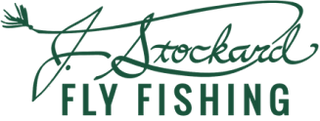Guest Blogger: J. Stockard Fly Tying Ambassador, Barry Ord Clarke, aka 'The Feather Bender' from Norway. See all of Barry's flies on his YouTube channel.
The Wally Wing May Fly Dun is an upside-down mayfly dun. "This is an interesting pattern for those of you that have not tied wally wings before," says Barry... "They may look challenging but using this method makes it easier."
Aside from its spectacular aesthetics, it is a highly effective fly. When fished, the Upside-Down Wally Wing Mayfly Dun sits low in the film and presents a very natural silhouette. The forward-facing hackle improves stability and helps the fly sit upright on the water. This is perfect for picky fish during mayfly hatches when traditional upright patterns may be refused.
Recipe
Hook: Mustad C53 #10-14
Thread: Grey
Tail: Coq De Leon
Wings: Mallard flank
Body: One black and two brown moose mane hairs
Thorax: Peacock herl
Hackle: Silver badger
Wally Wing Mayfly Dun - Step-by-Step
STEP 1
I'm tying this one on a size 12 Mustad C53S hook—any long, curved dry fly hook will do. I mount it in the vise upside down since this pattern is meant to ride hook-point up on the water. That inverted position gives the finished fly a better silhouette and keeps it riding properly during the drift.
STEP 2
I start my thread a few millimeters behind the eye and build a smooth base halfway down the hook shank. Nothing fancy here—just enough to give materials something to grip.
STEP 3
Next up is the tail. I’m using Coq de Leon , which has just the right stiffness and shimmer. I measure a clump to about the length of the hook shank and tie it in right on top. Because this fly rides inverted, the tail needs to support that posture, so I run the thread deep into the bend to make sure it’s secure.
STEP 4
Now I prep the body material. I take three strands of moose mane —two brown and one black. I even out the tips and tie them in so the body will darken at the tail and lighten toward the thorax, giving a nice natural taper. I wrap a thin underbody first, getting a slight taper as I move forward.
STEP 5
Once that's done, I twist the three moose hairs together and start wrapping the body. I keep them flat and parallel to each other. As I wrap forward, the body transitions from dark to light, which mimics a natural mayfly abdomen really well. When I reach the thorax area, I tie off the strands and trim the excess.
STEP 6
At this point, I rotate my vise to flip the fly right-side up—or hook-point down, technically—because now I’m going to tie in the wings. If you don’t have a rotary vise, just remount the hook upside down.
STEP 7
For the Wally Wings, I grab a large mallard flank feather. I gently strip and align an equal number of barbs from both sides, pull them down to form two loops, then dampen them a bit so they’re easier to shape. Here's where it gets fun—I thread the feather tip into a small plastic tube (I use an old UV resin nozzle) and pull it through to form neat, symmetrical loops. That gives me two pre-formed wings, ready to tie in.
STEP 8
I adjust the length, then secure the feather at the thorax with tight wraps, making sure the wings sit right on top of the hook shank. Once it’s locked in, I trim the butt and tie everything down cleanly. I use my fingers or bodkin to carefully split the wings—pulling a few fibers down on each side to separate them left and right. It takes a little finesse, but it really makes the wing stand out.
STEP 9
Next comes the thorax, which I build with peacock herl. I tie in a strand behind the wings and wrap it forward, creating a nice full thorax just ahead of the abdomen. Then I tie it off and trim the herl.
STEP 10
Time for the hackle. I choose a brown dry fly hackle, tie it in by the base just behind the eye, and give it a couple of wraps with the fibers sweeping forward —this gives the fly a better footprint on the water when it's riding hook-point up. Once I’m happy with the spread, I tie off the hackle and trim the excess.
STEP 11
To finish, I wrap a neat little head just behind the eye, whip finish, and snip off the thread. If I feel the wings need a bit more strength, I’ll give them a light coat of UV resin or varnish to help them hold their shape after a few fish.




1 comment
Steve
I love this Fly pattern. I learned about it from “The Feather Bender’s” web site last year. Follow his directions on hooks, especially this one. The very light hook and shape is necessary.
Also, follow the proportions closely, even maybe making the hackle one size larger. A larger wing helps ensure that it “parachutes” better making it land right side up.
A friend and well know tyer won’t tie this style of fly because he can’t get it to land correctly – but he is a stickler on size proportions and that can be your downfall.
Practice this fly, try a couple and adapt the proportions, and you will have an excellent fly. I love to drift it over submergent weeds, just under the water, and take the big girls from the pockets between them.
Tight lines my friends